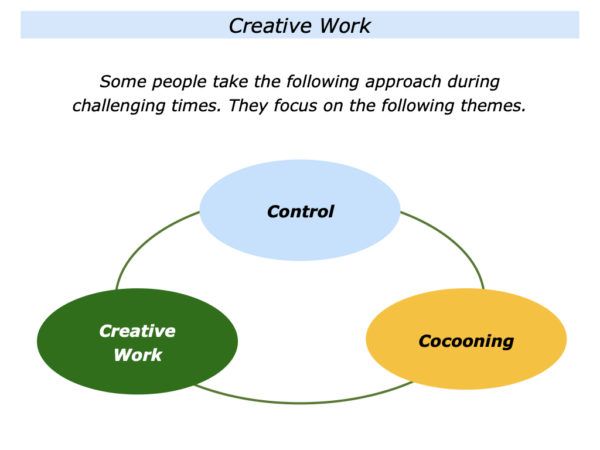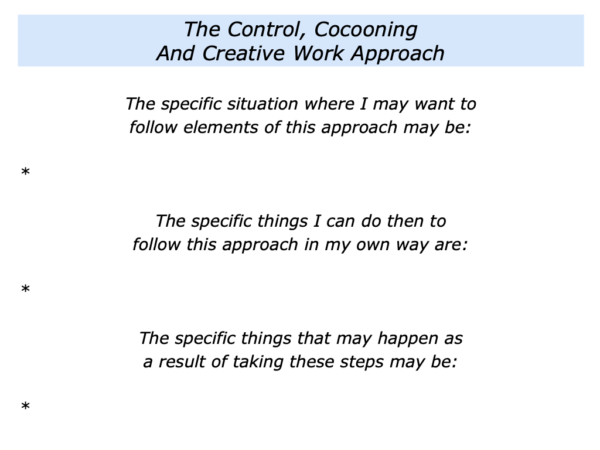
Different people choose different ways to do good work during challenging times. Some concentrate on the following themes.
Control – They start by focusing on what they can control in the specific situation.
Cocooning – They create a safe and stimulating place where they can protect themselves from distracting influences.
Creative Work – They aim to build on their strengths and do creative work.
A person may take this approach for personal, professional or even political reasons. Let’s explore these steps.
Control
Some individuals start by focusing on what they can control in a potentially challenging situation. Different people do this for different reasons. They may aim to do this, for example, when either:
They are embarking on a programme of medical treatment;
They are encouraging other people who face challenging circumstances;
They are aiming to spread practical hope – and retain their own sanity – when aiming to reverse climate change.
A person who wants to encourage other people, for example, may take this approach when feeling overwhelmed by events happening around the world.
Some individuals may start by aiming to be a positive model. They may then aim: a) to take simple steps; b) to set achievable goals; c) to do their best to achieve success.
One person took this approach after feeling depressed about the votes for Brexit and the 2016 US Presidential Election. They described what they did in the following way.
“I tried to be encouraging and kind in my daily life and work. The aim was to care for other people and the planet rather than to give in to cruelty.”
Let’s return to you own life. Looking ahead, can you think of a situation where you may want to build on what you can control? What could you to do to take those steps? What may be the benefits?
Cocooning
There are many forms of cocooning. Whilst Faith Popcorn popularised the term in the 1980s, it is an approach that has been followed by many people throughout history. Different people do cocooning in different ways.
Some do it by going into a sanctuary to gain comfort. Some do it by creating a safe place that is also stimulating. Some aim to do creative work by cutting off outside noise. Some do it by concentrating fully when tackling a challenge. Let’s explore these themes.
Cocooning For Comfort
Some individuals follow the cocooning approach to find comfort. They may rest, sleep or spend time in their chosen sanctuary. They may gain comfort by staying home or doing other things that bring solace to their soul.
Many people take this step to recentre. They may do it for hours, days or even years. Spending time in the cocoon can help them to refresh themselves. There may come a time, however, when they want to emerge.
Such individuals may then go out into the world to learn, do a stimulating project or aim to achieve a specific goal. They may go through the process of absorption, adventure and achievement.
They may sometimes return to their sanctuaries to make sense of what is happening and regain their strength. They may then alternate between spending time in their cocoon and being creative in the world.
Cocooning For Creating
Some people follow the cocooning approach when doing creative work. Many writers, painters, sculptors, designers, thinkers and others have taken this route throughout history.
Such individuals aim to create a safe place that can also be stimulating They aim to focus fully when pursuing their work. They therefore protect themselves from various influences that may be distracting.
As mentioned earlier, some sensitive people may aim do work that helps to build a better world. They may therefore cocoon themselves by creating a positive environment and stop exposing themselves to negative things happening in the world.
Cocooning For Tackling Challenges
Some individuals follow the cocooning approach when tackling challenges. They often start by gathering lots of information before settling on their strategy. They then focus fully on following their chosen process for working to achieve their goal.
Many athletes, golfers and other sports people describe how they follow this approach. They talk about being in their bubble but also being present in the moment.
They may have a positive mantra they say to themselves to keep focusing on the task in hand. They stay in the present rather than get ahead of themselves. Such individuals then do their best to achieve their picture of success.
Creative Work
Different people behave in different ways when facing challenging situations. Some may choose to simply build on what they can control. They then feel more able to shape their futures.
Some may gain strength by spending time in their version of a cocoon. Some may stay there for the duration of the challenging time. Some may choose to rehearse following certain plans and then go out into the world.
Some may focus on doing creative work. They may pursue a craft, write a book, make music, develop software, provide virtual mentoring, run a business from home or do another activity.
Some may focus on following the principles of stability, stimulation and success. They gain stability by being in their safe place but they also aim to get stimulation.
Some individuals get inspiration from books, music, art, exercise or other activities. Some get it from occasionally going out into the world to find solutions to challenges or help people. They may then do creative work and aim to achieve their picture of success.
Let’s return to your own life and work. Looking ahead, can you think of a situation where you may want to follow elements of this approach? How can you do this in your own way?
What may be the specific challenging situation? How can you build on what you can control? How can you spend time in your version of a cocoon? How can you then aim to do creative work?
If you wish, try tackling the exercise on this theme. This invites you to complete the following sentences.







Leave a Reply